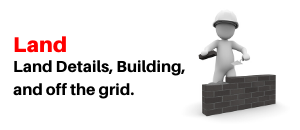Norm Geddis
Norm is a contributing writer at Online Land Sales, LLC.
Building
When you start to think seriously about building your own home from scratch, you usually want to start with a plan for what kind of house you want to construct. However, a lot of stuff comes before the construction process. Before you design your perfect home and hammer the first nail, you’ll need to deal with the state of your parcel, which is usually wholly undeveloped. You will also want to check on possible permit requirements for the building you are considering. Covenants for the subdivision should also be considered. At OnlineLandSales.com, we have a Land Due Diligence area that has county data and covenant data for each subdivision we have land in.
If you’re going to bring in a cabin or trailer, you don’t have to worry about clearing much of the land, but if you are building a home, the first part of the process is getting the ground ready.
Clearing The Land
Since the land you’ll be buying is undeveloped, that means it may need to be cleared before you build. One land plot in a development may have many bushes and undergrowth; another parcel may be home to numerous trees.
You’ll want to check your covenants for the rules regarding the amount of trees that can be cut. These rules usually exist to keep the natural beauty of the subdivisions, while providing ample allowance for building a home or ranch.
The main thing you’ll want to do in the ‘grubbing-up process’ is remove everything that protrudes from the land as much as possible from the area where the building will be. Tree stubs will need to be obliterated, usually using a grinder if they can’t be pulled out by another means.
Want to hire a removal company for the job? The clearing cost will vary depending on the forest cover’s intensity, including scrub, trees, stumps, and rocks. The amount to be paid depends on the size of the land and vegetation. Forest areas cost much more than areas with shrubs and grasses.
Costs for outsourcing to a removal company vary depending on the foliage, as much as $500 to $5000 per acre. Brush removal is a separate cost of between $200 to $600 per acre. You can see why there’s a big DIY incentive here.
Location
You’ll need to plan on where the building is going to sit on your lot. There are several things to consider here. Many parcels border two or more access roads. Most covenants have setback rules. That means any building must be built beyond the setback limit, the required distance between the house and the nearest street or creek.
Setbacks exist for aesthetic purposes and allow adequate distance for grading requirements set to manage runoff and flooding. When you clear the land, you’ll want to be aware of any future grading that will be necessary.
Utilities
An off-the-grid home living doesn’t necessarily mean living without electricity or other modern conveniences. Some rural subdivisions have electricity in them. But living without public electricity is very possible in many areas. Rural land restrictions tend to be few, and some areas have none. Indeed, if you are building a cabin for temporary use, such as hunting and camping, you probably don’t even want to connect to utilities. In other cases, you may want to install solar panels or other off the grid solutions.
Most off-the-grid homesteaders look for energy-efficient features, like deep-cell batteries, waste incinerators, nowater toilets, and innovative insulation systems.
A willingness to get your hands dirty again and again is the first skill you need. That alone will lead you to learn everything you need to build your future home. The natural world can provide all your basic needs, but you need knowledge and skills to use what is out there.
